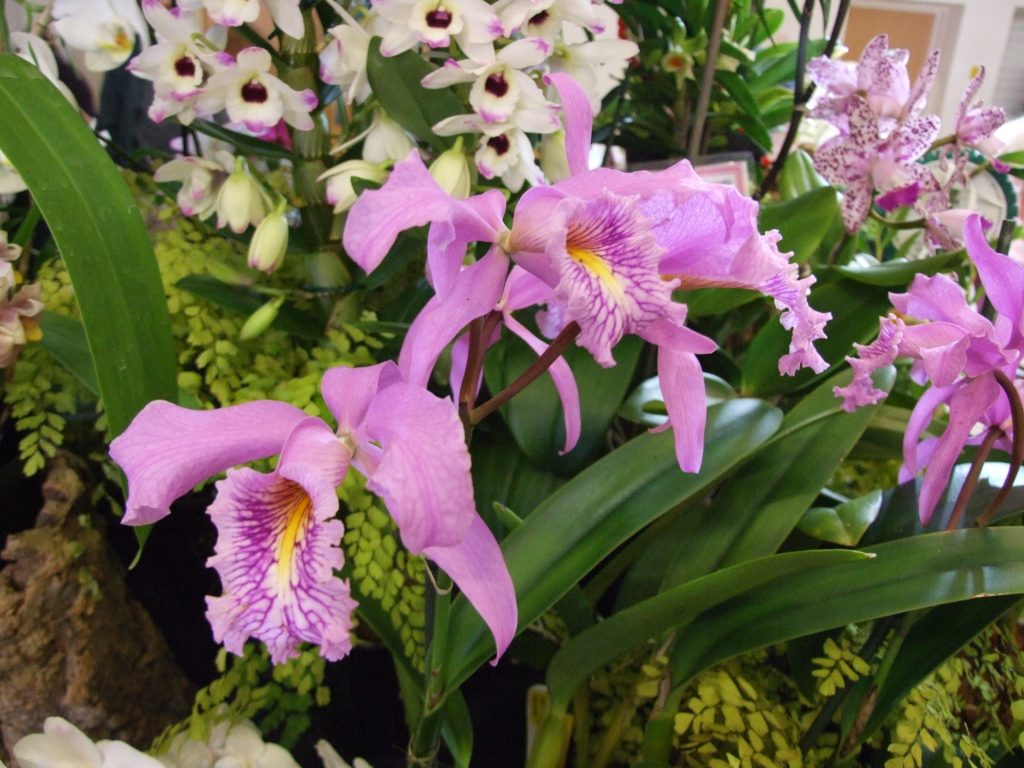Sheffield & District Orchid Society

General Cultivation Notes
The types of orchids that we grow in our greenhouses, conservatories or in the home would naturally grow in rainforests all over the world. We try to recreate these conditions to get the best from our plants and this need not be as hard as you think.
TEMPERATURE: Orchids usually fall into 1 of 3 categories – cool, intermediate or warm;
Cool: winter minimum 10°C (50°F) summer maximum 22°C (75°F)
Intermediate: winter minimum 12°C (55°F) summer maximum 25°C (80°F)
Warm: winter minimum 18°C (65°F) summer maximum 27°C (85°F)
The winter minimum temperatures are more vital for night-time and it is natural for there to be a rise and fall between day and night and between the seasons.
Make sure you do not grow your plant on a window sill that has a radiator below it, the constant warm, even, hot air will dry it out and damage it. Also make sure it is not in any cold drafts.
LIGHT: Orchids do not like bright light, in the rainforests only dappled light will reach them through the leafy canopy. Direct sun, especially in summer, can burn their leaves quite easily so keep them in dappled shade during the warmest months. In winter when the sun is not so strong, full light is fine and indeed necessary to help them to flower well the following season. Many people grow orchids on a windowsill. If you do make sure the plant is not baked in a lot of sunlight, such as on a south facing window, this will burn the leaves. West or east facing windows are usually ideal if they get a little direct sun early or late in the day. Also, particularly in winter, make sure the windowsill does not get cold at night, especially if you use curtains, these can trap in cold air from the window, if you are unsure grow your plants on a table near the window.
WATERING & HUMIDITY: Rainforests are naturally humid places so to create this at home you can grow other suitable companion plants such as ferns and air plants with your orchids. Misting the foliage and aerial roots several times a week, especially in warmer conditions will help the humidity. Take care when misting Phalaenopsis and phapiopedilums, make sure that the water does not collect in the crown of the plant, if it does, just use a thin sliver of paper towel to absorb it. Stand the pots on damp pebbles and the moisture will evaporate around the plants.
if you get bitten by the orchid bug and start a small collection of plants, think about adding a small humidifier to blow onto the plants. They will love the increased humidity, and it is also good for your health as well.
When it comes to actually watering the plants, do not rely on them taking up water from underneath the pot as this can lead to the compost becoming too wet. Instead take your plant to the sink and water from above, letting it run through the open bark- based compost two or three times. Then let it drain for ten minutes before you replace the pot into a ceramic pot or return to its tabel or windowsill. This is usually done 1 – 2 times a week with a little orchid fertiliser (about a 1/4 recommended strength of normal house plant fertiser) every 2nd or 3rd watering. Be aware that water straight from the tap may be very cold particularly in winter. It is best to fill a bottle or two with tap water the day before you water, and let it come to room temperature, luke warm, before you water. Sheffield tap water is Ok for orchids, but if you live in an area of hard water, then try to use rain water from a water butt. Never use softened water, it is deadly to orchids.
Avoid standing your orchids anywhere too hot and dry in the home. Directly above a radiator or television can provide a lot of dry heat, which simply dehydrates the plants more quickly. A bathroom or kitchen can often be the best places as these naturally are a little more humid.
Many houses now have conservatories attached to them and these can make ideal orchid growing areas. Shade, ventilation and humidity for summer and insulation and heating for winter are necessary though, so a few adjustments are usually required to make the conservatory “orchid friendly”. If these changes are not made then a conservatory can be quite desert-like with hot, bright and dry summers and cold winters, far from ideal for orchids.
Clean your orchids as well as your furniture! Household dust will collect on their leaves so wipe them regularly with luke warm water to keep them healthy and looking good.
Repotting your orchid will need to be carried out every two to three years. If you have bought it from a supermarket, you should repot as soon as it has finished flowering. Different orchids need different potting media, so check out the species or family specific pages here to learn what is the best media. Utube has a great many repotting orchid videoas, and these are ideal to learn how to do it.